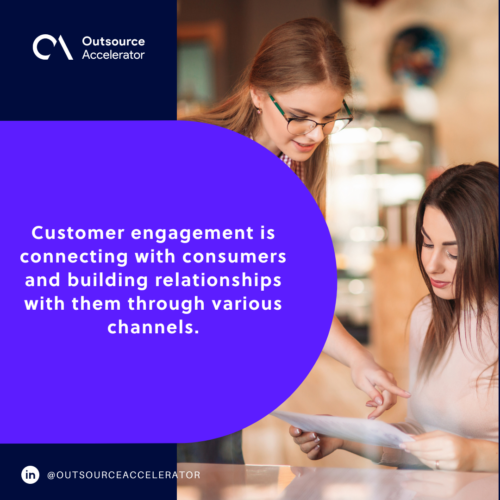Customer engagement process
Definition
What is customer engagement?
Customer engagement is connecting with consumers and building relationships with them through various channels. This process begins with an initial encounter and continues further than the point of purchase for several organizations.
Businesses can interact with consumers through social media platforms, email, websites, community forums, or any other medium in which individuals engage or gain material.

Why is customer engagement important?
Consumers and producers gain from customer engagement since it increases completion rates while fulfilling existing B2B customer expectations.
Maintaining customer engagement throughout the purchasing experience can also build customer loyalty and gain important consumer data.
Higher customer interactions make your brand more attractive to customers and offer you customer feedback. This consumer data can be used to guide marketing decisions like re-targeting and content generation, and sales procedures like messaging and outreach strategies.
Benefits of boosting customer engagement
Increased sales and company growth is the primary goal of every business. However, there are several other advantages to customer engagement that can establish your brand for long-term success and enhance your return on investment.
Improves customer relationships
Customer relationships have always been the backbone of conventional storefront enterprises. However, they are difficult to maintain in the modern era.
Innovation makes it easier to gain and advertise new prospects, but also makes it difficult to sustain customer relationships. Constant communication with consumers across platforms contributes to the development of relationships.
Customer engagement doesn’t end with the transaction. In fact, customers frequently ask questions throughout the process.
Boosts loyalty and customer retention
An effective engagement plan will ensure that you are constantly aware of how your customer feels about your product or service, the traits that they value, and any areas of development that are required to create a better experience.
You want your customers to feel acknowledged and valued since this reduces customer retention. Customers are more inclined to buy from you again if you show genuine interest in them.
Instead of simply providing a product, you become the accurate solution to their problem.

Increases users
Consistent interaction helps you gain consumers or engage their interest in your company and products. In customer relationships, many businesses provide incentives and freebies to express their gratitude.
Discounts and promotions are effective methods to attract potential customers, but you must also provide quality.
Companies that provide relevant information that answers important issues to their consumers receive a significant growth in users. As those consumers become more aware of your brand, it will gradually become their preferred choice and the product they choose over competitors.
Customer engagement approaches
Consider the following recommended approaches for incorporating customer engagement into your business.
1. Build a brand voice
Customers would like to engage with a brand that has a distinctive style. Many businesses have established themselves by employing a distinct brand voice. This gives the business a persona, making it more relevant and appealing to its customers.
Developing a brand voice establishes your business as a thought leader in its sector. Customers will consider you as an expert who can advise them on various goods and services.
2. Share your brand voice online
When you share your brand’s vision with others, it becomes more powerful. Start developing a presence using social media marketing, or like you would with your account.
Share messages with similar meanings and post material that matches your brand’s ideals. Advertising is an effective method to engage with people who have not yet engaged with your brand.
3. Personalize customer experiences
Some businesses, such as Amazon, use software to generate suggestions based on previous purchases.
It’s not like every business should invest in such advanced technology. Other strategies to customize customer engagement include asking consumers how you can assist them.
Some businesses start the customer experience by having customers fill up a user profile or take a survey in which they choose interests. This can get customer feedback from the start of the process and satisfy the customer.
4. Implement a chatbot
It’s simple to implement an AI-powered chatbot that collects information and can interact with people and assist them in selecting products they like.
Another advantage of chatbots for client interaction is that they allow you to provide consistent support even after hours.
This means that even when agents aren’t there, you don’t miss out on opportunities to capture consumers’ attention, collect contact information so people may reach out later, or answer routine inquiries more quickly.
5. Support your team
According to Hubspot, 93% of customers who experience excellent customer service are likely to repeat purchases. Certainly, customer-facing employees have a significant influence on customer engagement.
However, many businesses cannot support their staff in the same way that they assist their customers, which might have had an impact on customer engagement.
So, consider looking after your employees and provide supervision and telecommunications, motivate them, and reward their efforts. Only by taking care of your staff will you be able to provide the highest expected customer experience and keep consumers throughout life.







 Independent
Independent




